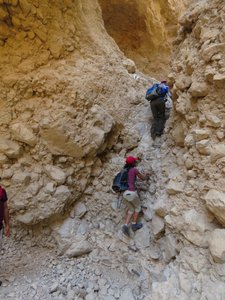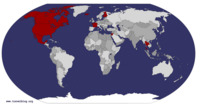Advertisement
Published: October 9th 2016

 Salvadora gulley
Salvadora gulley
Salvadora gulleyMy daughter and I drove down to the Dead Sea to join a group of families on a desert camping trip. We met up with the other families at the entrance to the Salvadora stream, about 4.5 km South of Mitzpeh-Shalem on the Dead Sea coast. Soon after, our guide Yoel arrived with the eternal Jean-Pierre. Those who have travelled with Yoel (much recommended) know that Jean-Pierre, Yoel’s beat-up old pink Renault Express, has been all over Israel, both on and off-road.
We all got organized, sun screen on, backpacks, water, snacks and kids, and started the day’s hike. We walked back up the road a bit to where the Salvadora stream crosses under the road and climbed down the ladder into the dry river bed (marked by a green trail marker).
After a short break in the shade of the Salvadora bridge, where Yoel told stories of past flash floods, we followed the green trail markers upstream. The Salvadora stream at that point is a narrow gulley, so it’s nice and shady. We climbed up a few boulders and dried
up waterfalls, passing by some strong oregano-smelling desert lavender (
Lavandula coronopifolia), thorny caper and some other desert plants, and pretty soon the valley opened up and we were in the full force of the sun.
Now, in some places October may be cool and pleasant. Unfortunately, the Judean desert is not one of them. Especially during a seasonal heat wave. Still, we persevered, wondering how the local plants and animals even survive here.
After a short while we stopped for a break in the shade of a rock wall to cool off a bit before climbing up the wall. We clambered over some rocks and around a small waterfall. At that point a blue trail branches off to the left the green (more on that later), and we came upon a rock platform covered in fossil seashells. From there we could already see the bright green patch of vegetation where the spring is located. A short walk further and we stopped to rest in the shade of some large boulders, with the stream’s namesake before us. The salvadora tree (
Salvadora persica) grows and thrives where it is because of a small spring hiding in the rock wall behind
it.
The spring is just a few drops seeping out of the rock and dripping down to the ground, but it’s an important source of water for the entire area. There is, of course, the large salvadora and the tamarisk growing over the spring, but we also saw ibex, golden spiny mouse, rock hyrax, tristram’s grackles, sinai rosefinch, oriental hornets and other animals that depend on the water and on the vegetation for food.
We all visited the spring and let it drip on us to cool off. Then we clambered a little further upstream, into the shade of a giant waterfall, the final step in one of the tallest waterfalls in Israel (almost 200 m tall). We stopped for lunch and coffee, told stories and had a little snooze before heading back to the cars.
We hiked down the same way we came up, until we reached the fork in the path. This time we took the blue path, which took us over a small ridge and directly back to the cars.
After cooling off and a much needed drink of cool water we all drove a little further north, to the Dragot road block
and left the vehicles in a small lot nearby. We followed Yoel down to the Dead Sea coast, past sinkholes and crusts of salt.
The water level of the Dead Sea is dropping at an alarming 1 meter per year, causing sinkholes and exposing natural springs of varying salinity and temperature. The sinkholes are only as deep as the water level in the sea, so the closer you get to the coast, the shallower they are. Be careful not to step too close to a hole, the ground around it may collapse and you’ll find yourself knee deep in salty mud.
Unfortunately, lots of folks like to come here and dip in the pools or camp out, and it isn’t a nature reserve or protected area, so trash abounds. Why people can’t take their trash with them when they leave is beyond my ability to comprehend.
We walked along the beach until we came to a relatively large, sweet water spring. Not sweet enough to drink, by any means, but sweet enough to support lots of shade-giving vegetation. We all dipped in the pool, enjoying the cool water for a while.
Later, after we were all
refreshed, we found a good camping spot overlooking the Dead Sea and prepared for the night. We set up our tents, lighting, a table, folding chairs… all the necessities of outdoor camping. Yoel prepared a wonderful dinner of soup, salad, schnitzel, and grilled cauliflower.
We ate, drank, told stories and enjoyed the solitude and silence under a ceiling of bright desert stars. Eventually everyone drifted off to sleep.
Morning met us with Yoel-made pancakes, scrambled eggs, coffee and tea, bread and various spreads (chocolate, humus, cream cheese). We packed ourselves up and prepared for another day of hiking. This time on a wetter trail.
We parked the cars at the entrance of the Arugot reserve and paid the small entrance fee. Then we headed upstream. Only this time it was really up a stream most of the time. The Arugot stream is fed by several springs and fresh, sweet water flows along most of it. So you can quite literally have one foot in the desert and the other in the jungle! Along the way we walked in the flowing stream, in the shade of the tamarisk and reeds, sometimes along the remains of ancient aqueducts. Yoel
pointed out the weaver ants, one of the few insects protected by law in Israel.
A short walk upstream brought us to the ‘Hidden Waterfall’. This is a flowing waterfall in the middle of one of the driest deserts in the world, and you can’t see it until you’re almost upon it! Of course we had to stop and get wet. You just can’t
not drop everything and jump in, right?
We played in the water, had a waterfall massage and in general had a good time for a while before heading further upstream. We climbed up the path alongside the stream, fully exposed to the searing heat of the sun, but after a while the path led us back into the shade of river vegetation and we came upon the Arugot stream’s upper pools. That’s where we stopped for lunch, more dipping in the pools and an afternoon snooze.
Each of us, in our own time, went a little further upstream (just a few meters) and saw the spring itself. Well, one of them (the stream is fed by several springs). The water bubbles out of two holes under the cliff on the right (north) side of the stream. The best drinking water you could dream of!
After our break we started heading back to the park entrance. This time we bypassed the waterfall and continued on the sunny path until, just about one kilometer from the park entrance we got to the slide.
Now, the slide is a spot where the water wore away at the rock, creating a smooth chute with a shallow pool at the bottom. You can slide down, falling the last meter or so into the pool, but beware! The pool is shallow! No more than 80cm, and the rock above the slide and around it is slippery. It is very easy to slip and fall, or land wrong at the bottom of the slide. In fact, that’s exactly what happened to a member of our group. She didn’t realize the pool was so shallow and landed with her legs straight. She hurt her leg and couldn’t walk. We all helped to carry her out of the park, calling for a stretcher from the park’s office along the way. As it later turned out, she broke her leg in two places.
Eventually we all made it back to the park’s entrance and to our cars and headed home.
So, a few notes about desert hiking and the trails described here:
• Dehydration and heat stroke are real killers! Drink. And I don’t mean the good stuff. Drink water. Lots. Then drink some more. All the water you carry is drinking water. Not for washing your face or pouring over your head to cool off.
• Carry lots of drinking water!
• Protect yourself. Always wear a hat, shirt with sleeves (don’t leave your shoulders exposed, they will burn!) and wear sunscreen and sunglasses!
• Always hike with a guide, or prepared. Know where you are going, wear suitable clothing, shoes, hat.
• Watch your step. A slip and fall can really ruin your day.
About this trip:
• Both the Salvadora and Arugot are relatively short hikes, and although not very easy, they are suitable for families with kids from the age of, say 5 or 6. If your kids like to climb trees, furniture & such, they should have a great time on both trails.
• There is no water in the Salvadora stream. Though it is not long (only about 2 km long), it isn’t an easy stroll so it takes longer than you’d think. Bring enough water (at least 3 liters per person). The worst that can happen is that you bring water back to your car.
• The Salvadora stream is part of a nature reserve, but it is open. There is no entrance fee.
• The Arugot stream is a nature park, but the entrance fee is minimal (28 NIS for adults, 14 for children, discounts available for groups, students, senior citizens) and the park is well worth the expense. The entrance fee also includes the nearby David stream and the ancient Ein Gedi synagogue (same day only).
• Many parts of the Arugot stream include walking in or near water, and the trail is sometimes narrow with a chasm to one side. Watch your step, watch your kids!
So, be careful but get out and enjoy!
Advertisement
Tot: 0.142s; Tpl: 0.013s; cc: 10; qc: 54; dbt: 0.0935s; 1; m:domysql w:travelblog (10.17.0.13); sld: 1;
; mem: 1.1mb









